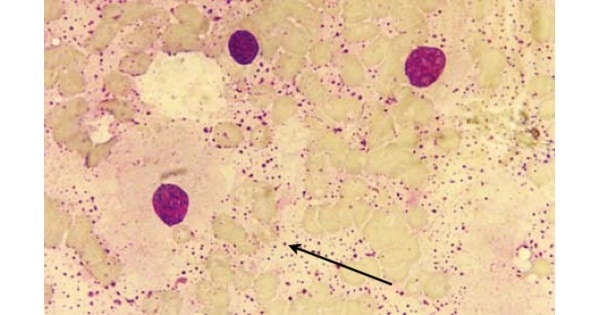Brucella
| A |
I (i) II (iii) III (ii) IV (iv) |
|
| B |
I (ii) II (iii) III (i) IV (iv) |
|
| C |
I (iii) II (iv) III (i) IV (ii) |
|
| D |
I (iii) II (ii) III (i) IV (iv) |
| A |
I (i) II (iii) III (ii) IV (iv) |
|
| B |
I (ii) II (iii) III (i) IV (iv) |
|
| C |
I (iii) II (iv) III (i) IV (ii) |
|
| D |
I (iii) II (ii) III (i) IV (iv) |
A farmer who is working in poultry developed acute onset of fever with chills. On physical examination, there is hepatosplenomegaly and lymphadenopathy. Blood culture shows Brucella abortus. He must have got the infection through all the following ways, EXCEPT:
| A |
Infected meat |
|
| B |
Ingestion of raw milk |
|
| C |
Man to man |
|
| D |
Contact with aborted fetuses |
A farmer who is working in poultry developed acute onset of fever with chills. On physical examination, there is hepatosplenomegaly and lymphadenopathy. Blood culture shows Brucella abortus. He must have got the infection through all the following ways, EXCEPT:
| A |
Infected meat |
|
| B |
Ingestion of raw milk |
|
| C |
Man to man |
|
| D |
Contact with aborted fetuses |
Brucella melitensis is commonly found in (animal)-
| A |
Pig |
|
| B |
Camel |
|
| C |
Sheep |
|
| D |
b and c |
Brucella melitensis is commonly found in (animal)-
| A |
Pig |
|
| B |
Camel |
|
| C |
Sheep |
|
| D |
b and c |
Ans. is ‘b’ i.e., Camel; ‘c’ i.e., Sheep
- Human brucellosis is a zoonosis, acquired from animals directly or indirectly. The animals that commonly act as sources:
Sheep, goat and camel melitensis
Cattle or Buffalo —> Br. abortus
Swine —> Br. suis
Dog —› Br. Canis
All are true about Brucella except –
| A |
B. abortus is capnophilic |
|
| B |
Transmission by aerosol can occur occasionally |
|
| C |
Paesturisation destroys it |
|
| D |
2ME is used to detect IgA |
All are true about Brucella except –
| A |
B. abortus is capnophilic |
|
| B |
Transmission by aerosol can occur occasionally |
|
| C |
Paesturisation destroys it |
|
| D |
2ME is used to detect IgA |
Ans. is ‘d’ i.e., 2ME is used to detect IgA
2- MercaptoEthanol (2-ME) agglutination test
. The 2ME ( 2-mercaptoEthanol) agglutination test is the most useful for differentiating active from inactive Brucellosis.
- In this test the IgM immunoglobulin is inactivated by treating with 2-MercaptoEthanol (2-ME) which breaks the disulfide bond and depolymerizes the IgM.
- The IgG immunoglobulin is resistant to depolymerization by 2- mercaptoethanol (2ME).
- The depolymerized IgM does not contribute to agglutination therefore the titre is primarily due to “ME resistant antibody (IgG)”.
- The 2ME agglutination test is most useful for differentiating active from inactive brucellosis in persons having ill defined complaint.
. The presence of 2ME resistant (IgG) brucella agglutinins indicates active disease in these patients.
- In addition 2ME agglutination test has been found to be superior to the routine agglutination test for determining the adequacy of antibiotic therapy.
. Adequate therapy reduces the IgG antibody level but not the IgM antibody level. If adequate therapy is not given this infection may progress to a state of chronic brucellosis in which the serological activity is mainly due to IgG antibody.
. A fall in 2ME resistant IgG antibody titre indicates satisfactory response to therapy.
About other options
. Brucella is capnophilic ( requires 5-10% CO2 for growth).
- Occasional the airborne infection ( by aerosol) may occur due to inhalation of dried material of animal origin.
. Pasteurization destroys brucella, therefore it is transmitted by unpasteurized milk.
Identify the biphasic culture medium used for Brucella culture as shown in the photograph below? 
| A |
Bordet Gangou medium. |
|
| B |
Regan Lowe medium. |
|
| C |
Castaneda medium. |
|
| D |
Cary Blair medium. |
Identify the biphasic culture medium used for Brucella culture as shown in the photograph below? 
| A |
Bordet Gangou medium. |
|
| B |
Regan Lowe medium. |
|
| C |
Castaneda medium. |
|
| D |
Cary Blair medium. |
Ans:C.)Castaneda medium.
The biphasic culture medium used for Brucella culture as shown in the photograph above is Castaneda medium.
- Sometimes, a culture system comprises of both liquid and solid medium in the same bottle. This is known as biphasic medium (Castaneda system for blood culture). The inoculum is added to the liquid medium and when subcultures are to be made, the bottle is simply tilted to allow the liquid to flow over the solid medium. This obviates the need for frequent opening of the culture bottle to subculture.
- It is used to grow Brucella from blood.
Brucella abortus primarily affects
| A |
Dog |
|
| B |
Cattle |
|
| C |
Swine |
|
| D |
Goat |
Brucella abortus primarily affects
| A |
Dog |
|
| B |
Cattle |
|
| C |
Swine |
|
| D |
Goat |
Ans. is ‘b’ i.e., Cattle
- Human brucellosis is a zoonosis, acquired from animals directly or indirectly. The animals that commonly act as sources
|
Sheep, goat and camel Cattle or Buffalo Swine Dog |
Br melitensis Br. abortus Br suis Br Cants |


